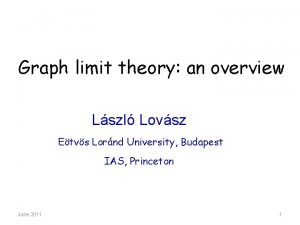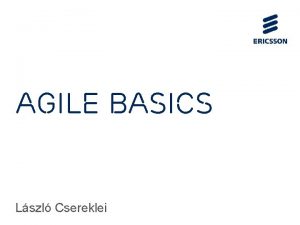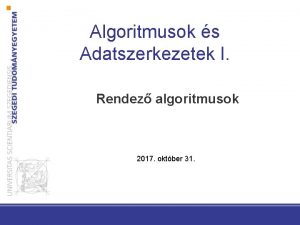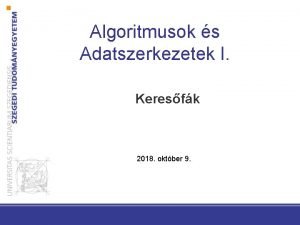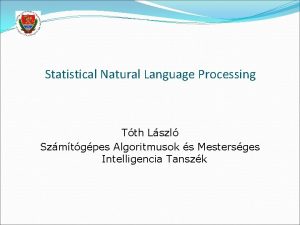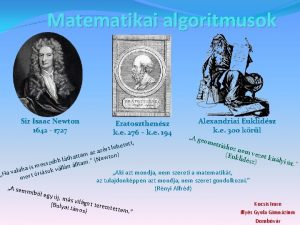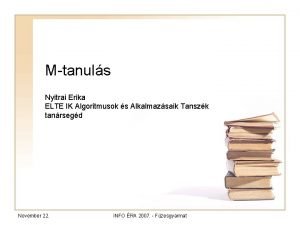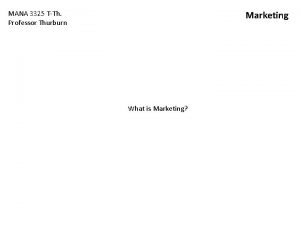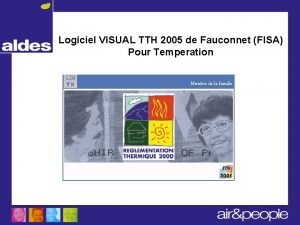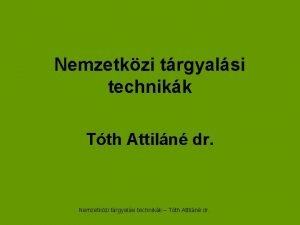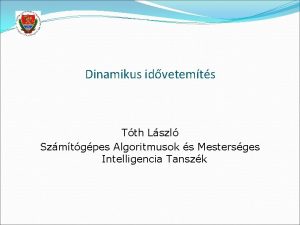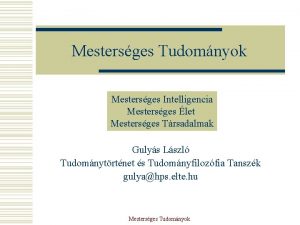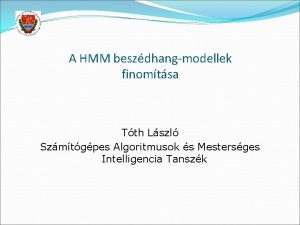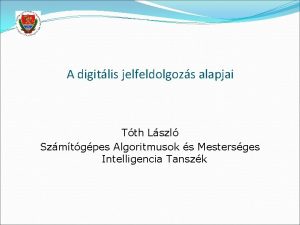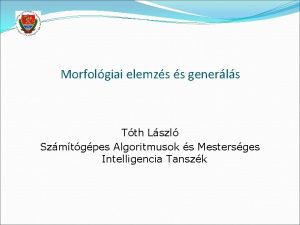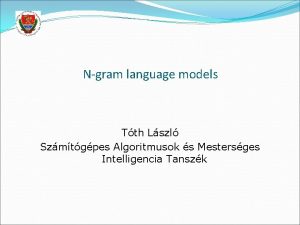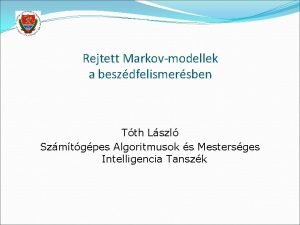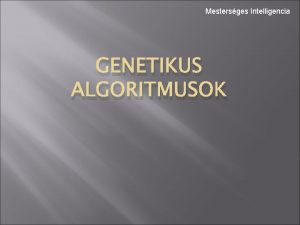Morphologic analysis Tth Lszl Szmtgpes Algoritmusok s Mestersges










- Slides: 10

Morphologic analysis Tóth László Számítógépes Algoritmusok és Mesterséges Intelligencia Tanszék

Words and word forms In a natural language the number of word stem is around 100 000 Eg, in a large Hungarian dictionary there around 70 000 words But in any text database we will find many more word forms Mainly because one word may have several inflected forms (and party because we may forms compound words) In English one word may take only a couple of forms Have have, has, had; hats English speech recognizers simply solve this by listing all possible word forms (that is, they define “word” as anything that may occur between two spaces) The main European language families (german, neolatin, slavic) use significantly more word forms But in Hungarian the situation is even worse (one noun may have about 700 inflected forms) Similar languages are Finnish or Turkish For these languages, listing all word forms is practically unfeasible Can we create a language model that decomposes words into stems and suffixes?

The morphology of Hungarian Morphology is the field of linguistics that studies word forms Hungarian is so rich morphologically, because it allows to use 3 types of suffixes after each other Pl: jó+ság+om+ért (for my good+ness) Our goal here is to separate the stem and the 3 types of suffixes The main problem with this is that their combination is technically not a simple concatenation Some example for the plural sign “+k” nők (in this case, this is simple concatenation) alma almák (here the last vowel of the stem is modified) házak (here we insert a vowel between the stem and the suffix to ease pronunciation) kéz kezek (here we use a different inserted vowel, and the stem is also changed…)

Koskenniemi’s two-level morphology The problems shown can be handled by Koskenniemi’s two-level morphological model (originally invented for Finnish) Building blocks: A set of stems and suffixes (morphemes) („ the lexicon”) Set of rules Lexical (upper) level: a sequence from the elements of the lexicon Surface (lower) level: the word form created Rules set: it defines the mapping between the 2 levels E. g. : When the stem ends in a vowel, then no “filling” vowel is necessary Advantages: Easy to implement Works in both direction, so it van be used both for analysis (decomposing a word form) and generation (generate all possible forms of a given stem) Disdvantage: it cannot be trained, must be filled up with words manually Implementation: using finite-state transducers (FST)

Word form analysis by statistical methods The Koskenniemi model would be hard to use in a speech recognizer For example, if we put the suffix +k in the word set, how would we handle the variants +k, +ak, +ek ? By the pronunciation dictionary? In the output, how would we reconstruct the word form from its parts, e. g. ház +k házak? So, to make it simple, we return to the simple concatenation approach We don’t bother with the conversion rules between the two levels, we simply include all possible variants in the dictionary (see the right side below: ) nő, +k alma, almá+, +k ház, +ak kéz kez+, +ek The “word pieces” obtained this way are not always correct morphemes in a linguistic sense (they are sometimes called “morphs”), but in a language model of a speech recognizer it makes no problem Of course, the number of components increases (eg. instead of +k we will have +k, +ek, …), but it is not a large increase compared to the number of stems In the output we only need concatenation (+ denotes the parts that must be fused)

Morfessor is a software that can decompose words on a statistical basis A Finnish tool, one of the oldest solutions for word decomposition There exist other, newer tools like MORSE It recursively splits the words in the training set into smaller parts (see image on left) Of course, all words should be decomposed at the same time (see image on the right) What makes a good decomposition (how can we formalize the goal)? The obtained word pieces should cover the training dataset as much as possible The number of word pieces should be as small as possible We want to avoid oversplitting: the units should be as long as possible (the number of splitting steps should be as small as possible)

The weaknesses of Morfessor 1 st problem: it is inclines to oversplit rarely seen words We could solve this by specifying a list of known words that should not be split The MORSE tool allows of forbids splitting based on semantical similarity (eg. It allows the decomposition locally local+ly, because local and locally have similar meaning, but the decomposition freshman fresh+man is forbidden, because the meaning of freshman is not related to the meaning of neither fresh nor man) 2 nd problem: it does not exploit the fact that certain components can only be stems, while other components can only be suffixes (for example, a word cannot begin with a suffix) It has an extended version which has the categories prefix+stem+suffix E. g. in Hungarian: el+megy+ek Remark: how does it handle compound words like freshman? 3 rd problem: When applied to Hungarian, it does no recognize letters that consist of 2 characters (like sz), it frequently cuts them into two

Morfessor in speech recognition Creating a language model using Morfessor We decompose the word forms into smaller units („morfokra”) using Morfessor We can train an n-gram model over these units In the speech recognizer output, we must concatenate a stems+suffixes, but we can identify these by denoting the suffixes by a special starting character like + Advantages: Much smaller dictionary smaller search space, faster decoding, smaller memory requirement Much fewer OOV words, smaller perlexity Disadvantages: We must train higher order n-grams (to see the stem of the previous word) The output might contain incorrect word forms Theoretically, the training dataset contains no such incorrect stem+suffix forms But language model smoothing will assign small non-zero probabilities to these

Results for Hungarian Recognition of Broadcast news (Tamás Grósz, 2020): OOV rates and recognition error rates for word decomposition with different “strengths” (Vari. KN: Kneser-Ney n-gram smoothing): Telephone conversations (Mihajlik et al. , 2019) Word-level OOV: around 3% Word-level model: 100 000 words; morf-model: 30 000 morfs Language model: back-off n-gram trained on a dataset augmented using transformer neural networks They tried two types of language models with different memory footprints (modifying the strength of smoothing)

„Word piece” models End-to-end modeling would be much easier if we had fewer components (acoustic model, pronunciation dictionary, language model) For example, can we simply drop the pronunciation dictionary? The acoustic model could try predicting letters directly, instead of phones However, in English the connection between letters and phones is not as simple is in most other languages (the pronunciation is strongly influenced by the context) We must use longer word pieces, learning their pronunciation makes more sense In „word piece” models, the length of the units we try to recognize varies between one letter and whole words Typically used in end-to-end recognizers with no pronunciation dictionary Trained on a LARGE database, it might work even without a language model The word pieces are formed by algorithms that operate similarly to Morfessor Example: a Google paper (using a train set of 12 000 hours): State-of-the-art speech recognition with sequence-to-sequence models, 2018 Error rate: 5. 8% without a language model, 5. 6% with a language model
